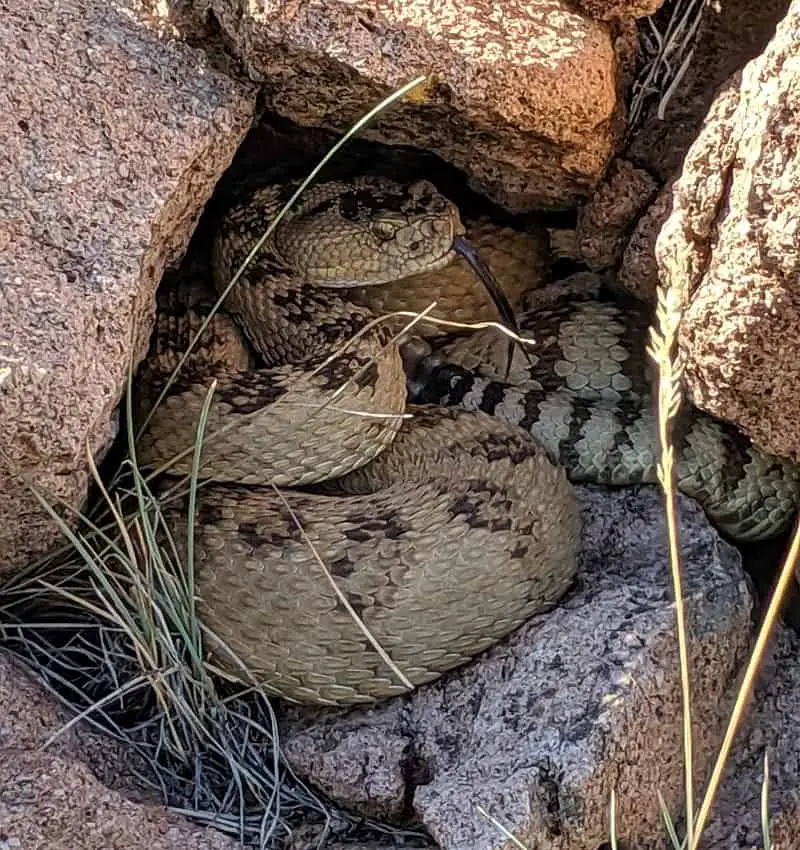Rattlesnakes are venomous reptiles with heavy bodies and triangular heads. They are known for their segmented rattle at the end of the tail. When disturbed, they vibrate their tails, making a buzzing or a rattling-type sound to warn predators. These venomous snakes are found throughout North, Central, and South America, although the largest concentration is in the Southwestern United States and Northern Mexico. In this article, we will discuss some interesting facts about these snakes.
1. Rattlesnakes are pit vipers
Like all pit vipers, rattlesnakes have a set of heat-sensitive pits on their head between the eye and the nostril that allows them to locate their prey and move towards it based on thermal radiation. These pits are only effective within a one-foot range but give them the advantage of hunting warm-blooded prey at night.
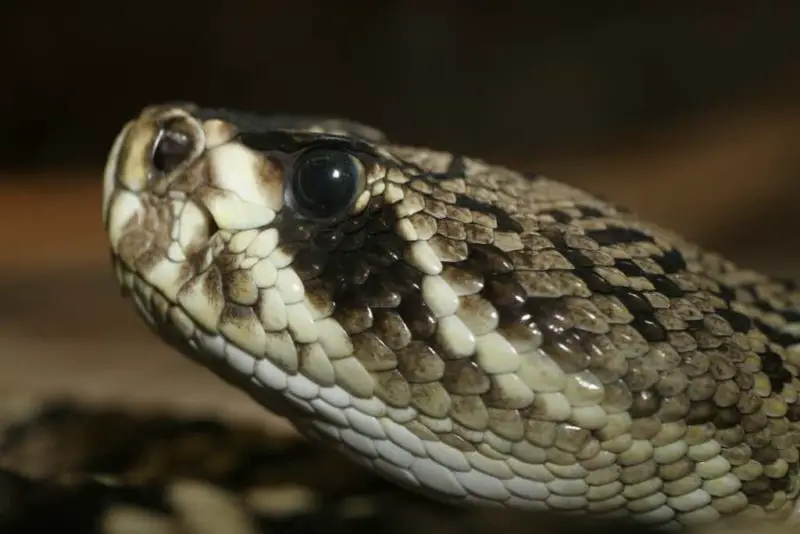
2. Rattlesnakes have vertical pupils
Rattlesnakes have vertical or elliptical pupils. It has been suggested that these slits help with depth perception and make it easier to ambush their prey. Their eyes are well adapted for nocturnal hunting, but their vision is more acute during daylight. They cannot see sharply defined images, so they rely on the perception of movement to locate their prey.
3. Rattlesnake’s fangs are retractable
Rattlesnakes have long, hollow fangs in the front of their mouth. These fangs are hinged to fold back against the roof of the mouth when the mouth is closed and automatically brought forward when the mouth is opened. They use their fangs to inject their venom into their prey.
4. Rattlesnakes give live birth
Rattlesnakes are ovoviviparous, meaning they give birth to live young after carrying their eggs inside. Female rattlesnake’s eggs pass through her body cavity and into two oviducts, where the eggs are arranged in a continuous chain waiting to be fertilized. After mating with the male in the fall, the female rattlesnake can then store the semen within her body until the following spring, when the eggs are then fertilized.

5. Male rattlesnakes do combat dances.
Males of some rattlesnake species, like the timber rattler, fight other males during mating season, competing over the females. These combat dances consist of two male rattlesnakes intertwining the anterior part of their bodies with their heads and necks held vertically. The larger males generally drive away the smaller ones.
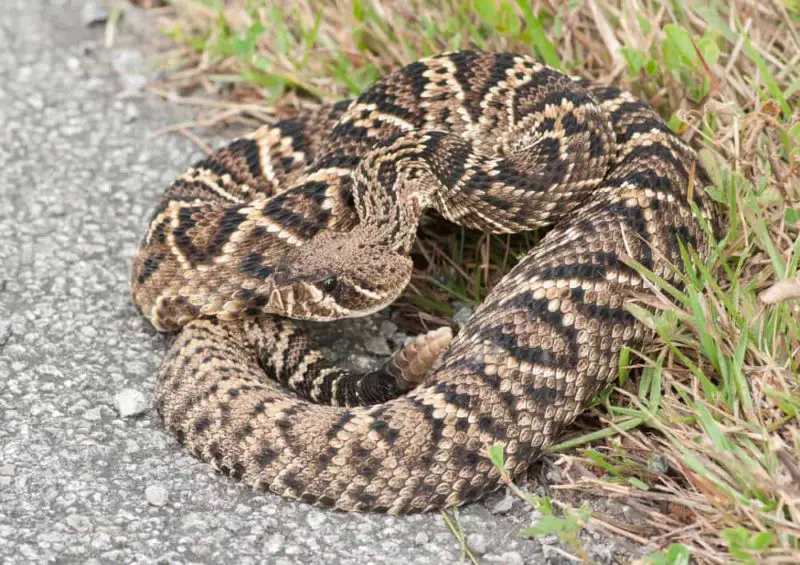
6. Eastern Diamondback is the largest venomous snake.
The heaviest and longest rattlesnake in North America is the Eastern Diamondback Rattlesnake (Crotalus Adamanteus). On average, they measure 3-6ft to the tip of the tail. According to “The Guinness book of animal facts and feats,” in 1946, there was an eastern diamondback rattlesnake that was shot that measured 7.8 ft (2.4 m) in length and weighed 34 lbs (15.4 kg).
7. Timber Rattlesnake is the 3rd largest venomous snake
The Timber rattlesnake is the 3rd largest venomous snake in North America and is also highly dangerous due to its long fangs, large size, and high yield of venom. On the other hand, there aren’t that many bites from this snake because of its long hibernation period and mild temperament.
8. The Diamondback is the most deadly rattlesnake
The most deadly rattlesnake is the diamondback. It is responsible for most deaths due to snakebite in the United States.
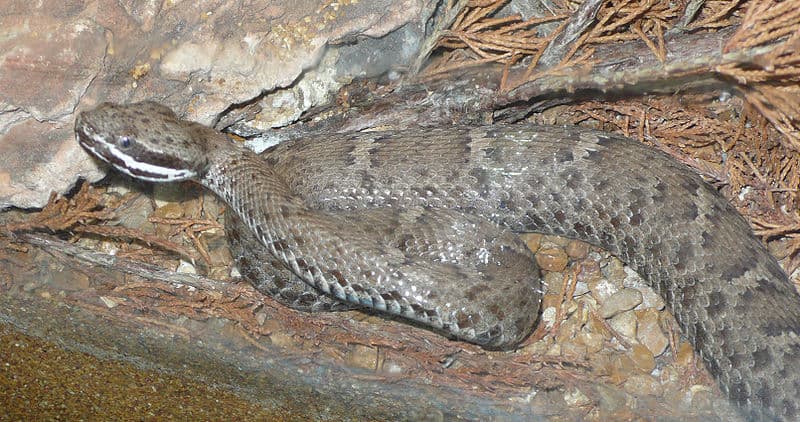
9. Ridgenosed rattlesnake is the smallest rattlesnake
Ridge-nosed rattlesnakes, which are found along the sky island region of New Mexico, Arizona, and Mexico, are the smallest rattlesnakes, growing up to 12–24 in (30–60 cm) in total length from their nose to the tip of their tail.
10. There are 48 known species of rattlesnake
All 48 species of rattlesnakes are native to the Americas, stretching from British Columbia to Ontario in southern Canada and on to central Argentina.
- Crotalus adamanteus, Eastern diamondback rattlesnake
- Crotalus angelensis, Angel de la Guarda Island speckled rattlesnake
- Crotalus aquilus, Queretaran dusky rattlesnake
- Crotalus armstrongi, Western dusky rattlesnake
- Crotalus atrox, Western diamondback rattlesnake
- Crotalus basiliscus, Mexican west coast rattlesnake
- Crotalus campbelli, Campbell’s rattlesnake
- Crotalus catalinensis, Santa Catalina Island rattlesnake
- Crotalus cerastes, Sidewinder
- Crotalus culminatus, Northwestern neotropical rattlesnake
- Crotalus durissus, South American rattlesnake
- Crotalus ehecatl, Tehuantepec Isthmus rattlesnake
- Crotalus enyo, Baja rattlesnake
- Crotalus ericsmithi, Guerreran long-tailed rattlesnake
- Crotalus horridus, Timber rattlesnake
- Crotalus intermedius, Mexican small-headed rattlesnake
- Crotalus lannomi, Autlan rattlesnake
- Crotalus lepidus, Rock rattlesnake
- Crotalus mictlantecuhtli, Middle American rattlesnake
- Crotalus mitchellii, Speckled rattlesnake
- Crotalus molossus, Black-tailed rattlesnake
- Crotalus morulus, Tamaulipan rock rattlesnake
- Crotalus oreganus, Western rattlesnake
- Crotalus ornatus, Eastern black-tailed rattlesnake
- Crotalus polisi, Horsehead Island Speckled rattlesnake
- Crotalus polystictus, Mexican lancehead rattlesnake
- Crotalus pricei, Twin-spotted rattlesnake
- Crotalus pusillus, Tancitaran dusky rattlesnake
- Crotalus pyrrhus, Southwestern speckled rattlesnake
- Crotalus ravus, Mexican pygmy rattlesnake
- Crotalus ruber, Red diamond rattlesnake
- Crotalus scutulatus, Mojave rattlesnake
- Crotalus simus, Middle American rattlesnake
- Crotalus stejnegeri, Long-tailed rattlesnake
- Crotalus stephensi, Panamint rattlesnake
- Crotalus tancitarensis, Tancitaro rattlesnake
- Crotalus thalassoporus, Louse Island speckled rattlesnake
- Crotalus tigris, Tiger rattlesnake
- Crotalus tlaloci, Tláloc rattlesnake
- Crotalus tortugensis, Tortuga Island diamond rattlesnake
- Crotalus totonacus, Totonacan rattlesnake
- Crotalus transversus, Cross-banded mountain rattlesnake
- Crotalus triseriatus, Dusky rattlesnake
- Crotalus tzabcan, Yucatán neotropical rattlesnake
- Crotalus viridis, Prairie rattlesnake
- Crotalus willardi, Ridge-nosed rattlesnake
- Sistrurus catenatus, Massasauga
- Sistrurus miliarius, Pygmy rattlesnake
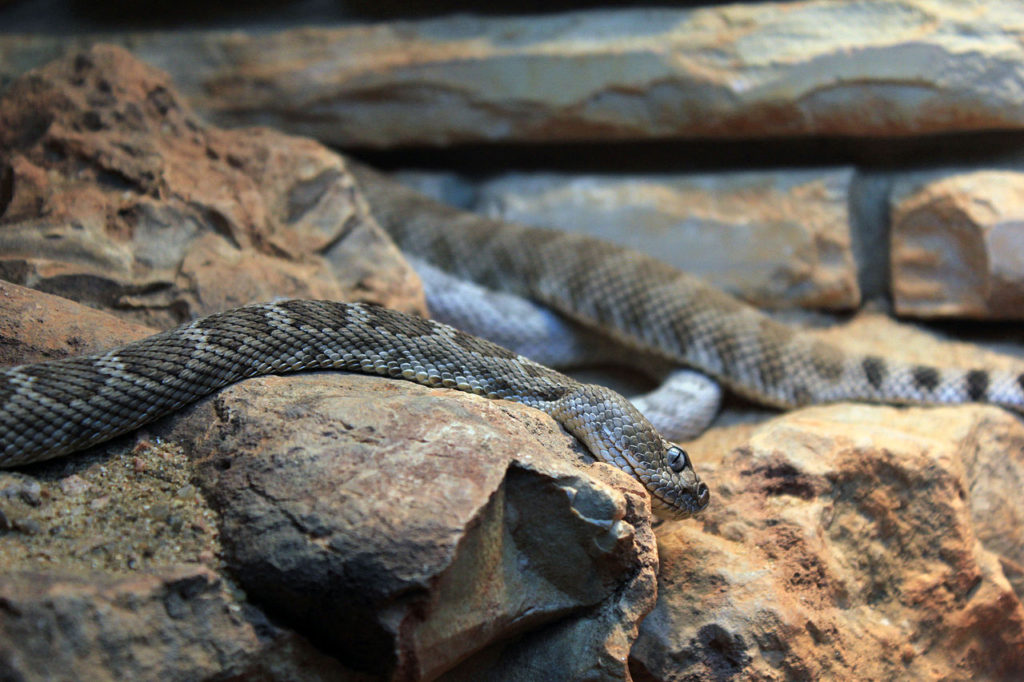
11. Santa Catalina Island Rattlesnake has no rattle.
This small and slender rattlesnake grows 2 ft 4inches at the most, but its most distinguishing feature is that it has no rattle. Unlike other rattlesnakes, they lose the rattle when they shed rather than forming a new segment. This is believed to be a localized adaption for hunting birds, enabling them to sneak up on their prey.
12. More people die from wasp and bee stings than rattlesnake bites.
More than 8,000 people are bitten in the United States by venomous snakes every year. On average, there are ten resulted deaths reported from a snakebite. On the other hand, according to the CDC, there are 62 deaths by wasp, bee, and hornet stings on average.
13. How far a rattlesnake can strike
Before striking, rattlesnake’s bodies are coiled except for their rattling rattle and their upper body that is upright, ready to strike. Rattlesnakes can strike at a distance equal to 1/3 – 1/2 of their length.
14. Rattles are made from keratin like our fingernails
The rattlesnake’s rattle is made of individual rattle segments of keratin, the same substance our fingernails are made of.
15. Adult rattlesnakes eat every two weeks
Adult rattlesnakes only need to eat once every two weeks; on the other hand, juvenile rattlesnakes will eat more frequently. After the rattlesnake consumes its meal, it takes up to 5 days to digest it.
16. Baby rattlesnakes are born with one rattle segment
Newborn rattlesnakes are born with one keratin segment at the end of their tail. They grow a new segment each time they shed their skin. They will typically gain 2-3 segments each year.
17. Age of a rattlesnake
It is a widespread belief that the number of segments in a rattlesnakes rattle determines their age, but this isn’t true. They grow a new segment each time they shed their skin, and young rattlesnakes do this more often than older rattlesnakes. Their end segments regularly break off with day-to-day activity, so there for the number of segments on its tail does not indicate the rattlesnake’s age.
18. Rattlesnakes play a vital role in our ecosystem.
Rattlesnakes are scary and venomous, but they play an essential role in our ecosystem by helping to control the small rodent population.
19. Rattlesnakes can’t tolerate excessive heat or cold
Rattlesnakes’ ideal temperature is between 80- 90 degrees. If they get too hot, they will seek shelters like rocks or underground burrows and then come out at night to hunt for prey. When temperatures fall to freezing, they often gather in large numbers, over 1,000 snakes, inside underground rattlesnake dens for a period of brumation (similar to hibernation) during the winter months.
20. Rattlesnakes require their body weight in water.
To stay hydrated, rattlesnakes annually require their body weight in water. The manner in which they drink depends on their source of water. For example, in ponds or streams, they submerge their heads and drink water by opening and closing their mouth, which sucks the water in. In small puddles, they sip the water by flattening their lower jaws and letting the water flood their jaws.
21. They are born with fully functioning fangs
Rattlesnake babies are born with fully functioning fangs and can envenomate their prey. Adult rattlesnakes shed their fangs every 6-10 weeks. They have three pairs of replacement fangs waiting behind their functioning pair.
22. Rattlesnakes have a sharp sense of smell
Rattlesnakes have an acute sense of smell. They use both their nostrils and the forked tongue to collect scent baring stimuli from the air about them, which is then carried to the Jacobson’s organs which are located in the roof of their mouth.
23. Arizona has the most rattlesnake species
The state of Arizona has the most species of rattlesnakes. They have 14 species with 4 subspecies.
- Arizona Black Rattlesnake (Crotalus cerberus)
- Great Basin Rattlesnake (Crotalus lutosus)
- Grand Canyon Rattlesnake (Crotalus oreganus abyssus)
- Twin-Spotted Rattlesnake (Crotalus pricei)
- Tiger Rattlesnake (Crotalus tigris)
- Banded Rock Rattlesnake (Crotalus lepidus klauberi)
- Mojave Rattlesnake (Crotalus scutulatus)
- Western Diamondback Rattlesnake (Crotalus atrox)
- Speckled Rattlesnake (Crotalus mitchelli)
- Northern Blacktail Rattlesnake (Crotalus molossus)
- Crotalus Viridis
- Hopi Rattlesnake (Crotalus viridis nuntius),
- Prairie Rattlesnake (Crotalus viridis viridis)
- Ridge-nosed Rattlesnake (Crotalus willardi willardi)
- DesertMassasauga Rattlesnake (Sistrurus catenatus edwardsii)
- Sidewinder Rattlesnake
- Mojave Desert Sidewinder,
- Sonoran Desert Sidewinder,
- Colorado Desert Sidewinder
How Many Venomous Snakes are in Arizona?
24. King snakes are immune to rattlesnake venom
King Snakes are a significant threat to rattlesnakes because they are immune to the rattlesnake’s venom, and rattlesnakes are part of their diet. When a kingsnake is nearby, the rattlesnake enacts a defensive posture known as body bridging. The rattlesnake keeps its head low to the ground to thwart the kingsnake from attaining a grip on it. He then jolts his body while bridging his body upwards, which forms a coil. This elevated coil shields its head and is used to strike the kingsnake.
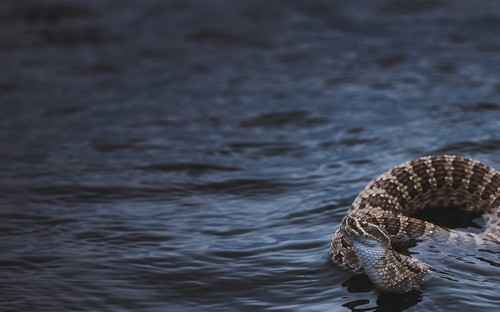
25. Rattlesnakes are great swimmers
Although they are mostly desert dwellers, you might find it interesting to know that rattlesnakes are great swimmers. They can easily swim across any body of water to get to their destination. In fact, Timber rattlesnakes can swim both below and above the water.
Recent Posts
The only venomous snakes in Washington State are Northern Pacific Rattlesnakes. The Northern Pacific Rattlesnake (Crotalus oreganus oreganus) is a sub-species of the Western Rattlesnake. Anyone...
Skunks are not classified as true hibernators. But they go into a state of torpor when the weather gets cold. Skunks are light sleep hibernators, along with opossums, bears, and raccoons. ...

